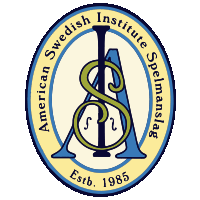Our Music
Edwin Johnson, Nall Jon Eriksson, Roy Lind, Gunnar Helberg, Gust Anderson, and Edith Lind playing at the American Swedish Institute circa 1960. Photo by Roy Svedvik.
The music we play represents a living tradition that started hundreds of years ago in Sweden. The melodies were made by women as they sang to their cattle in the summer pastures; by miners and loggers as they marched to and from their work; and by countless common people who enjoyed singing and dancing with family and friends. The music and rhythms lifted their spirits as they experienced joys and sorrows together. Sweden's tradition of fiddle music goes back hundreds of years as well. Swedes say they have a tune for every occasion from weddings, baptisms, and funerals to dances, feasts, and holidays.
The tunes we play might never have reached Twin Cities audiences if one man hadn't loved the fiddle. Edwin Johnson left Sweden during the 1920s, when drought and a weak economy drove many Swedish farmers to America. Edwin (born Ivares Edvin Jonsson) left Rättvik, on the shores of Lake Siljan in Dalarna, when he was 19 years old. He intended to stay in America for just a year. He packed his bags and his fiddle, but his mother forbade him to take the instrument, saying, "You're going to work, not to play." In America, Edwin couldn't bear being without a fiddle, so he built himself a new one. And he decided to stay in this country.
He met Nall Jon Eriksson, who grew up in the same fiddling tradition in Rättvik, and the two played together at many Swedish-American social events in Minnesota. Edwin met and married Elsie, also from Rättvik, and raised a family. He taught his children and grandchildren to love the music from his homeland. His son Bruce Johnson and his grandson Paul Dahlin played with him for many years as the American Swedish Spelmans Trio.
After Edwin died in 1984, Paul continued his grandfather's legacy and further advanced the tradition in America by organizing and leading our group. The ASI Spelmanslag, organized in 1985 with a dozen players, grew out of fiddle classes Paul taught at the American Swedish Institute. It currently has more than 40 fiddlers of all ages, from teenagers to octogenarians, many of whom were in Paul's original classes.
Samples
If you are a member or regular attender of rehearsals, click here for our song catalog.

